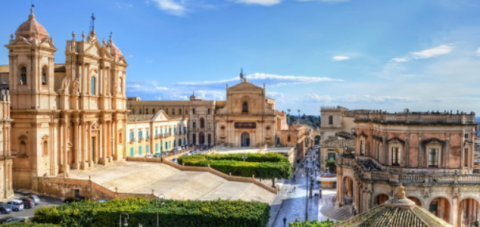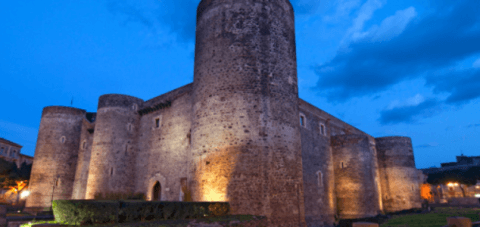East
Noto

Capital of Sicilian Baroque, the town retains numerous churches and palaces from the 18th century, many since rebuilt after the 1963 earthquake. The typical yellow colour of the local stone enabled the architects to created some very special areas making this a magical town. The cathedral with its baroque façade and works within is a must see, as is the Church of Christ crucifix with the sculpture by Laurana from the 15th century, the Church of Santa Chiara, the Church of the Immaculate Conception, The Nicolaci palazzo, the municipal library and the archaeological museum.
Syracuse
The provincial capital of Syracuse was founded by the Corinthians in 743 BC and later became the largest Greek colony in Sicily.The Corinthians landed on the east coast of Sicily, settling on the island of Ortygia.The island was probably connected to the mainland by a bridge that could be cut for greater defense. In almost all subsequent centuries, it suffered from not only destruction by man, but also from earthquakes in the 16th and 18th centuries as well as from many human losses due to the plague. The Doric Temple of Athena which is an integral part of the cathedral is worth a visit. The Arethusa fountain is a small lake formed from a freshwater spring that flows near to the sea. It is rich in fish and is unique in Europe for its abundance of papyrus plants. The Maniace castle is one of the most important monuments from the Swabian period. The Temples of Apollo and Artemis (6th century BC) and Athena (7th century BC). The Paolo Orsi museum is dedicated to the archaeologist who devoted his life to the study of Sicily.
Next, we have Syracuse, the city on the mainland. The main remains of the ancient Greek neapolis lie within in the archaeological park. On the hill of Temenite is the most beautiful and majestic ancient Greek theatre, inaugurated in 474 BC and completely surrounded by nature.Even the "Latomie", the deep stone quarries used as prisons are spectacular. The Latomia del Paradiso, at 45 metres deep contains the famous "Ear of Dionysius", this tunnel whose shape resembles an ear has an excellent echo.The Eurialo Castle which sits 8 km from the city, was a key part of the defense system protecting the area from land attacks.Near the Ciane River (the only place in Europe where papyrus grows) there are two columns with a stylobate of the Temple of Zeus Olimpian from the 4th century BC.
Catania

This ancient Sicilian town which for centuries was fought over by the Syracusans, the Greeks and the Carthaginians was conquered by the Romans in 263 BC.It has been ruled at different stages by the Byzantines, Saracens, Normans and the Aragonese.
To see:
Catania Cathedral completed in 1092 and rebuilt in 1693, with its famous dome of St. Agatha, houses the burial place of the famous composer Vincenzo Bellini.
The Ursino Castle, built in the 13th century by Frederick II, which now houses the town museum that contains Greek and Roman sculptures, a collection of vases and a rich exhibition of paintings.
The Greek theatre, rebuilt in Roman times, which can hold about 7,000 spectators.
The ruins of a Roman amphitheater from the 2nd century AD that could hold more than 15,000 people. The Collegiate Church with its splendid 18th-century façade, and its paintings and frescoes of great value. The symbol of the city since 1736, the Fontana dell'Elefante (fountain of the elephant).






